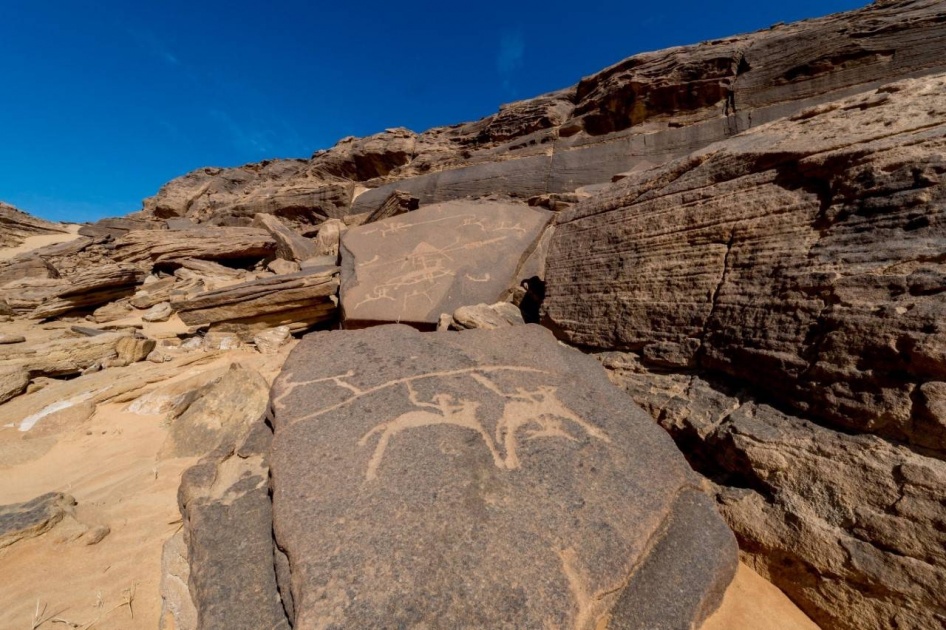
Najran poised to become world’s largest open museum of rock inscriptions
Saudi Gazette report
NAJRAN — The southern region of Najran is set to become the largest open museum of rock inscriptions in the world, according to Saudi archaeologists. They attached their expectations to the findings of the research teams, who are currently carrying out their mission, after the discovery of more rock inscriptions in the region that is among the richest rock art regions in the world.
Discoveries of inscriptions are still being made, especially in the site known as Bir Hima, which abounds in unique rock inscriptions and drawings. Bir Hima is among 10 sites that have been approved, following the request of the Ministry of Tourism, to be registered in the UNESCO’s World Heritage List.
Najran is famous for its historical and archeological sites, which are rich with ancient rock inscriptions and writings. The inscriptions narrate the stories of consecutive civilizations that continue to stand in images after thousands of years.
There are around 100 sites of historical and archeological importance. The recent archaeological discoveries in the region, carried out by specialized Saudi and international teams, explored civilizations that date back to the Stone Age.
According to the latest discoveries, the origin of Najran’s civilizations dates back to the Upper Paleolithic period. Researchers also found traces of very old lakes that have now disappeared, showing that this area was historically significant, with ancient Arab kingdoms fighting over it to control this green oasis.
It has also been made clear that the location was economically significant because of its main passage being one of the most important trade routes at that time.
The strategic location of Najran contributed to it being a passage for the tribes of western and central Arabia. Najran was distinguished by its presence among several countries having their own civilizations.
This fact made it an important center through the ancient trade route, which heads to the northeast of the Arabian Peninsula, all the way to Mesopotamia or Makkah, Madinah and AlUla, and then Petra, the Levant and Egypt.
Najran was an important center along the Incense Route. Caravans originating at the source in Yemen passed through Najran before turning northward.
The region has important monuments and sites that dates back to the Byzantine, Umayyad and Abbasid periods, all of which confirm that the region was an important commercial and agricultural destination, with remarkable cultural depth.
Bir Hima is considered as the largest site of rock carvings in the Kingdom. It is located about 130 kms in the north of Najran, housing several archaeological sites such as Mount Sidah, Mount Hima, the sites of Ain Jamal, Shasaa, and the Planet that are rich in inscriptions and drawings, which were the first human attempts to write the ancient alphabet.
The rock inscriptions and drawings on this site were a historical testimony to the attempts of man to write the alphabet, which was known as the “Southern Musnad” calligraphy.
Flourishing of trade in this region as the ancient caravan route was attributed to the existence of Hima wells and this contributed to the spread of the alphabet.
Those who crossed this route recorded their memories and drawings in Al-Thamudi and Southern Musnad calligraphy, along the road, and around the caves, and in the foothills of the mountains at the Hima wells.
Bir Hima contains seven wells, including Hamata, Suqya, Jannh, Umm Nakhlah and Al Qarayen, most of which were dug in the rocks, and they are considered as landmarks of ancient civilizations of this place.
Caves and mountains surround the site from all sides, except the eastern side — which is full of drawings and rock inscriptions that include drawings of human beings and animals.
The rock art of Bir Hima is an eloquent expression of relationships between humans and the environment, with a lot of drawings and engravings testifying to climate changes, wildlife migrations, and the evolution of humankind on the region.
The Saudi-French mission, which is carrying out the explorations, discovered many rock inscriptions and drawings, including those of humans and animals.
The themes of these inscriptions were diverse, reflecting aspects of human life in those eras such as hunting, war and dancing. The method of carvings was also diverse, using different techniques of engraving and coloring.
The mission also uncovered many inscriptions of the Musnad calligraphy, which was famous in the southern part of the Arabian Peninsula. The abundance of Musnad script in Najran showed the importance of the trade route in linking southern Arabia with the central and northern parts of the Arabian Peninsula.
Hence the region became a popular destination and target of the kingdoms of southern Arabia, such as Sabaeans and Himyarites, especially during the three centuries before the advent of Islam.
The Saudi-French mission was able to unearth Nabataean inscriptions at the site of Mawadi Shamsa and to discover the Kufic inscriptions scattered in sites in the region that date back to the first and second centuries after Hijrah.

























